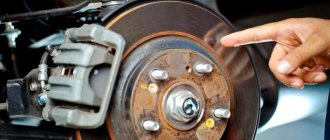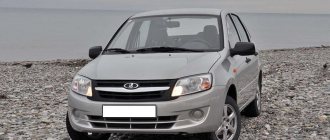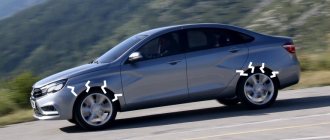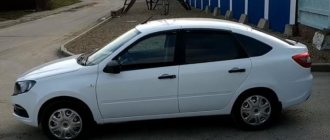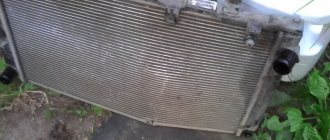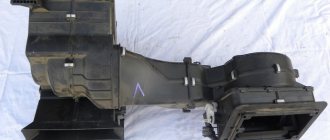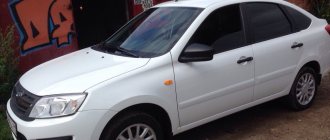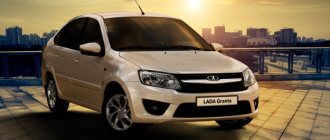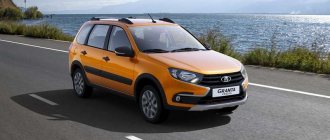● Deformation of the brake disc guard
● Uneven wear and scoring on the disc or drum.
Diagnostics on a lift
A lift will help check the suspension for play. Turn each lever in different directions one by one. If serious play appears, repair the identified damage. It is from this node that the extraneous sound is emitted.
You can also check the wheel bearing here. To do this, rock the wheel to the sides. If there is play, the bearing is broken.
Pay attention to any extraneous noises you hear. Even the smallest noise can lead to a serious problem and vehicle repair. It is necessary to diagnose these malfunctions in a timely manner to prevent further wear and tear on the vehicle’s mechanisms.
Source
Where do extraneous sounds come from?
The causes of extraneous sounds are varied. Some problems can be solved on your own.
Dirty pads or their critical wear
An unpleasant squeal can be heard in the area of the front wheels when braking. The pads consist of a friction clutch and a metal base. During braking, the clutch wears off and the metal base comes into use. A characteristic sound of grinding metal appears.
Dirty pads
If new pads are installed, but the unpleasant noise remains, do not panic. This may be due to uneven disc wear. As you move, the pads will rub in and the extraneous noise will disappear. A problem with the rear pads can occur if they are installed incorrectly. Watch how the pads are installed.
Steering faults
The load has a strong influence on the ball joints. If they are worn out, a characteristic knocking sound is heard in the area of the right and left wheels. Immediate diagnosis is necessary.
If the caliper breaks, you will hear a squeaking and grinding noise. This is caused by jamming of the working cylinder or caliper guides. The pads are constantly pressed. This is caused by:
- a leaky boot that could become clogged with dirt;
- oxidation of the cylinder itself or the guides, which prevents it from returning to its original position.
Steering faults
This problem can be diagnosed by feeling the deterioration of the roll and slightly pulling towards the pinched wheel.
Mechanical damage
Large uneven roads wear out the suspension, which can also be indicated by noise from the front of the car. The problem could be a worn wheel bearing or CV joint.
The protective shield (metal casing of the brake disc) may be deformed.
Incorrect wheel size
A grinding noise may appear after installing wheels of larger diameter when they rub against the arch. It is necessary to install a tire size that meets the requirements for a particular vehicle.
The rear wheel of the Lada Granta shuffles
Dimon wrote: Sometimes something shuffles on my left side that I don’t know and don’t want to know, for some reason it only appears in dry, warm weather.
hmm, but mine is wet and dirty. I decided it was dirt. scored. Now that it has become clean and dry, this sound has become a kind of squeak, but from the front. I looked at the pads - almost like new. x.z. what's happened
Has anyone encountered this problem?
I placed washers under the cotter pin that holds the lever on the rear block (so that there is no loose hanging on the axle)
After changing the rear wheels (tires and wheels), I also started to hear a knocking noise, as it turned out it was the bolts that secure the wheel that were knocking (they rubbed against the brake pads), I solved the problem by grinding off a 2-4 mm bolt (bluntly with a file)
PS> If the bolt is rubbing against the pads, you can easily find out by unscrewing the bolt and looking at it; if it is rubbing, then characteristic wear from friction will be visible there!
Friction also occurs after replacing old brake pads with new ones, simply because they are new and will rub against the drum for some time!
After changing the rear wheels (tires and wheels), I also started to hear a knocking noise, as it turned out it was the bolts that secure the wheel that were knocking (they rubbed against the brake pads), I solved the problem by grinding off a 2-4 mm bolt (bluntly with a file)
PS> If the bolt is rubbing against the pads, you can easily find out by unscrewing the bolt and looking at it; if it is rubbing, then characteristic wear from friction will be visible there!
Friction also occurs after replacing old brake pads with new ones, simply because they are new and will rub against the drum for some time!
the bolts that secure the wheel were knocking (they were rubbing against the brake pads),
, I thought about tightening the handbrake, although it already works at the 3rd click.
In fact, this partially solves the problem, I adjusted it to 2 clicks, but still sometimes something happens, and sometimes it’s absolutely silent, in short, I’ve put some crap on it because it’s unclear and doesn’t interfere.
nonsense, the bolts rub against the handbrake cable
If you consider the wear of the bolts that I had, then the handbrake cable would have been worn to dust from such friction!
Source
How does a car work?
You can understand where the extraneous sound comes from by understanding the structure of the car.
Suspension
The purpose of the suspension is the connection between the wheels and the car body. The suspension helps smooth out bumps due to the fact that the wheels work independently of the body.
It consists of:
- springs, springs;
- shock absorbers;
- levers - to connect the wheels with the body;
- supports;
- connecting elements (silent blocks, hinges, ball joints).
Cause of extraneous noise
The cause of extraneous noise may be hidden in the suspension. Main reasons:
- Faulty levers (play in the joints, possible failure of silent blocks).
- Shock absorber failure or spring break. In this case, a knock appears when overcoming bumps.
If a cracking sound occurs when turning, the CV joint is to blame. It cannot be repaired and must be replaced.
Brake system
In general terms, the braking system consists of:
- brake drive (brake pedal, brake master cylinder, pressure regulator, vacuum booster, pipes);
- brake mechanism (brake discs or drums and the pads themselves);
- in some cases - electronic control elements (ABS).
When braking there is a knocking sound in the rear wheel "Grants"
When braking, a knocking sound in the rear wheel of the Granta indicates wear or contamination of the brake system elements. The most common cause is rubbing handbrake cable guides. It needs to be tightened or replaced.
Steering system
The steering system is necessary to control a car. It consists of:
- steering wheel;
- cardan;
- electric booster;
- steering rod;
- tie rod ends.
Sounds emanating when turning the steering wheel indicate loosening of the components, partial or complete wear of the bushings. If the anthers are damaged, dirt can get inside the mechanisms, which causes a grinding noise.
Exhaust system
The exhaust system includes a manifold, catalyst, exhaust pipe, muffler, and resonator.
If extraneous noise appears in the exhaust system, it is necessary to check the fastenings of all elements. The resonator may burn out, and a loud growl will be heard from under the car.
Comments • 49
Beautiful Pavel, I had the same problem at 100 thousand miles. I did as you showed, the creak disappeared!!
There are already a lot of comments about music, I join. I only understood from the comments what was poured into the syringe. Well, in general, thanks, we’ll give it a try.
What kind of liquid should I put in there? Oil ? Nigrol?
Thanks to the author of the video. I spent a long time looking for what was creaking, the fault was the support bearing, after watching this video, it squeaked like mine, even on the same wheel. I went and bought a syringe of 5 cc (too bad the needle was thin), and injected probably 1.5-2.0 cc of a “faith” injection. Oh my god it doesn't squeak anymore. But I still ordered reinforced ball joints and will change them. The car (Kalina 2, produced in 2022) covered 70,000 km. Once again, respect and respect to the author.
How many cubes should the dose be?
I have a 2022 Grant Fl, mileage 3000, the chassis is already creaking, what the heck..
@Egor Kuznets, I went for a ride today, including several times driving along the fucking path from the house to the asphalt and back. The good thing about silicone is that it retains normal softness during temperature changes. I’ll ride like this for now, if it creaks again, then I’ll come up with something else. I was very surprised by the fact that I didn’t really have to tighten anything in the suspension and chassis. I remember the new seven was turning almost the entire bottom.
@Vadim Kryuchkov the handbrake cable can be pulled out of the bracket, where it rubs against the body. And secure with zip ties. People do this right away. I tried to put rubber bands on it, but after a heavy rain it started squeaking again.
@Egor Kuznets, there is no market, our concern is everything. Well, okay, when I took bucket 21074 15 years ago, well, there didn’t seem to be much to ask. A tractor is a tractor, although unlike the Soviet-era sevens, the new one turned out to be just brutal crap. And here it’s like it’s not a big deal. After 15 years, it’s like you’ve gone to heaven. Everything works, there are brakes, a heater, the steering holds, as if you were driving on rails. A song, not a car. And I drove a hundred kilometers and I started listening to bugs, crickets, spiders. I made noise from everything, from seven to ten, otherwise it’s impossible to drive. The noise from the wheels is hellish, especially in winter on asphalt. I’ll make noise with this one over time, but the car was bought in principle so that for five years it would be stupid to pour gasoline and change the oil, and not crawl under it. My mileage per year is less than 10 thousand now. That’s why I tensed up when the new car started creaking. Eliminated this creaking and croaking yesterday. I drove it into the pit and stretched everything that was below and that could be pulled under. I inserted spacers from food-grade silicone hose into the brackets holding the handbrake cables.
@Vadim Kryuchkov and regarding quality, this is a small matter, easily resolved. Any car requires love and care.
@Vadim Kryuchkov you’ve gotten really crazy here. Don't worry, it won't fall apart. For 6 years I have been driving Kalina 2 on such roads that after overloaded trucks in the heat, all that remains is asphalt. It’s really a pity to ruin a foreign car on such roads for 1.5 - 2 lamas. And it’s tall and doesn’t catch on the bottom.
You turn up the music in the car and not in the video, and the squeaks will disappear
Reasons for the appearance of extraneous sounds
Extraneous sounds are classified by nature. Thanks to this, you can understand what kind of malfunction occurred.
Rumble
This noise can be heard inside the car when a wheel bearing fails. A metallic knock when kicked on the Granta wheel indicates the same reason. As the speed increases, the noise increases along with it.
Wheel bearing
The noise may become louder when turning. If the car turns left and a knocking noise occurs in the front right wheel of the Granta, there is a very high probability that the front right CV joint has failed. This occurs due to an increase in load on the side opposite to the turn.
Rare knock
The sound that appears periodically on uneven roads most often occurs due to the ball joint. The problem may be in the suspension - in the shock absorbers. Oil may have leaked from them or the bushings may have worn out, and periodic knocking noises may also be heard when driving on rough roads.
Silent blocks and pillows
Silent blocks and pillows could fail. With minor irregularities, the sound may not be felt, but if the nature and direction of the load changes, they will manifest themselves.
Constant knocking
If you hear a constant sound when driving, pay attention to the steering mechanisms; they are often the cause. In the Grant, a knock coming from the rear means that the hub axle bolts are loose or the rear suspension fasteners are loose, or the handbrake cable is getting caught.
Creak
In most cases, squeaking is related to the brake system when parts rub against each other. It is necessary to check the serviceability of the pads and brake disc. The creaking noise in the Granta rear wheel is associated with oxidation of the brake piston, which prevents the pads from returning to their original position.
Grinding
The grinding noise warns the car owner that the suspension is faulty. Another reason is damage to the car’s mechanisms when driving over bumps.
Suspension fault
A grinding noise when braking in the rear wheel of the Granta, as well as in the front, may indicate wear on the pads.
Extraneous sounds during acceleration
The sound that appears when accelerating can come from the alternator belt - you can hear a characteristic whistle. The noise disappears when reaching a certain speed. To eliminate the cause, it is necessary to tighten the alternator belt.
Sounds while braking
Noise when braking is most likely related to the brake system. The block itself may make noise if it uses a low-quality friction mixture.
Dirt that sticks to the disc and gets on the pads leads to extraneous sounds. Uneven wear of the disk or drum, the appearance of scoring and irregularities lead to the appearance of extraneous noise.
What material is used to eliminate squeaks?
- bitoplast;
- anti-creak
Few owners know the use of each material; they are often considered identical, but this is not so.
Anti-creak is often called “madeline”, after the same name of the component included in the main composition. Madeline is a thin material, not intended for noise and vibration insulation. Suitable only for eliminating squeaks.
Bitoplast - also known as “Shumka”, has a thick fiber structure, is used primarily to reduce noise and vibration levels. It is not used as an anti-skripin. Although they sell it in stores as a universal remedy, which is fundamentally wrong.
Related link:
Review and installation of muffler attachment for Lada Granta Liftback
How to determine the cause of extraneous sounds
The appearance of extraneous sounds means that some mechanism has become unusable. Do not delay this issue until strange sounds lead to serious and expensive repairs.
Sound Source Localization
First you need to understand where the noise came from. To do this, warm up the car and listen carefully to the engine compartment. Here you can understand from which mechanism the extraneous sound comes from.
Car stethoscope
Listen to how the car behaves on the road, whether there is a hum when accelerating or braking. Extraneous noise may occur when turning.
There is a special device for “listening” - a car stethoscope, with which it is easy to determine where the noise is coming from. The operating principle of a car device is the same as that of a medical stethoscope.
Most likely malfunctions
The table shows typical problems signaled by sound.
| Character of sound | Possible faults |
| Rumble | ● Wheel bearing hums ● Transmission malfunction |
| Knock | ● Play in ball joints ● Steering rack and pinion wear ● Wear of shock absorber pads ● Wear of support bearings ● Loose suspension fastenings |
| Grinding | ● Poor quality or worn brake pads ● Deformation of the brake disc guard ● Wheel friction on the arch ● Uneven wear and scoring on the disc or drum. |
Diagnostics on a lift
A lift will help check the suspension for play. Turn each lever in different directions one by one. If serious play appears, repair the identified damage. It is from this node that the extraneous sound is emitted.
Creaking noise when hitting speed bumps - causes and diagnosis
In recent years, speed bumps have become commonplace on many inner-city roads in our cities. Most often they are placed near educational institutions and in other areas that require increased attention and reduced speed by the driver. Experienced drivers respect these speed limiters because they know that such obstacles can be overcome no faster than 20 km/h. Otherwise, you may incur the cost of repairing the chassis and steering.
Grantanswer #1
Many Lada Granta car owners sooner or later have various questions about the car. Experienced owners have fewer such questions, while beginners have more. Our “Grant Answer” section has been prepared just to answer your questions.
Crunching when engaging second gear Complaints about the crunching of second gear from owners of the VAZ 2181 gearbox have become more frequent. Even the official representatives did not name the reason. The problem can be partially or completely solved by replacing the gearbox oil with a more expensive synthetic or semi-synthetic, compared to the semi-synthetic that was filled from the factory.
The car is under warranty, what can I do with it? Cancellation of the warranty is an action that leads to a change in the normal operation of the vehicle's mechanisms. That is, you can connect the “music” yourself, if you already have audio preparation, without losing the warranty, since you do not interfere with the operation of the machine’s mechanisms. If you made any changes, for example, you installed fog lights or an alarm yourself, then only those parts that you changed and that are associated with the changed parts will be removed from the warranty. For example, if you installed fog lights, then you will be deprived of the warranty only for those parts of the wiring that you worked with, and you have no right to remove the warranty for the engine, gearbox, body and other parts that remained unchanged.
The door frames are rubbing against the seal. Causes and methods of treatment. The reason for the rubbing is the hard contact of the door frame with the upper seal. The solution to the problem will be adjusting the doors. If the paint has already rubbed down to the metal and you are afraid of rust, or rust has already set in, then clean the damaged area with light sandpaper, clean off any remaining rust, apply a rust converter according to the instructions, apply primer and a little paint and varnish.
Which wheels will be the most comfortable to ride on? Maximum comfort on R13 185/75.
Are there rubber seals for the rear windows and windshield and rear window? There are no standard seals, the craftsmen fit the windows from the Lada Kalina hatchback, and the rear window from the Lada Kalina Sedan. But they don’t fit standardly, so different people have difficulties with installation.
Is it possible to install standard lockers from Lada Kalina on Lada Granta? Yes, there is such a possibility, since the arches of these cars are identical.
The gearshift lever cracks in the third or fourth gear of the VAZ 2181 gearbox. The crackling is caused by incorrect operation of the gearbox cables. The case is under warranty, PSSS replaces the assembled cables in response to such complaints.
My door seal has broken, can I replace it under warranty? Formally, no. A torn seal most often indicates a violation of operating conditions and is not a warranty case. However, some dealers are flexible and can replace it for you free of charge.
Can I install an outside temperature sensor on the Lada Granta? Yes, if you have the latest instrument panel firmware. For installation instructions, read our article installing an outside temperature sensor on a Lada Granta.
They say that the metal thickness of the Lada Grant and Lada Kalina-2 is thinner compared to the Lada Kalina-1, is this true? No it is not true. The thickness of the sheet metal remained unchanged and is 0.6 millimeters.
How to remove crickets from the interior? We have a fairly detailed article on this question on our website. Removing instrument panel squeaks on Lada Granta.
In the video version you can hear answers to other questions directly or indirectly related to the Lada Granta.
Don’t forget to leave your questions in the comments and on the forum, and also look at our other articles.
Installing glove compartment lighting for Lada Granta Installing roof rails for Lada Granta
Lada Granta liftback technical specifications
Review of the standard MMC Lada Granta
Installing parking sensors on Lada Granta
